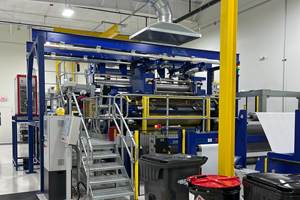Show Coverage: SEMA 2005 Showcases Auto Aftermarket
Carbon composites lead charge in growing add-on parts segment.
It was all about the bling-bling at the SEMA automotive show, held Nov. 1-4, in Las Vegas, Nev. Sponsored by the Specialty Equipment Market Assn. (SEMA), the event overflowed the Las Vegas Convention Center with Swarovski crystal embedded emblems, shining chrome, glittering paint jobs and plush leather, with a bit of carbon fiber thrown in. An estimated 120,000 people visited exhibits from 2,000+ manufacturers on a show floor that covered more than 1 million ft2 (roughly 92,900m2). Retail spending on products sold by SEMA members hit $31 billion (USD) last year, a five-year increase of 35 percent, says SEMA director Chris Kersting. The products fall into four broad ranges: tires and wheels, in-car electronics, performance parts, and body and appearance accessories. Composites find use, for the most part, in the latter, with a few parts, primarily carbon fiber, beginning to make a showing in the performance category.
The SEMA show was held in conjunction with the Automotive Aftermarket Products Expo (AAPEX), which was located in the nearby Sands Expo Center. The AAPEX show has been described as "the stuff you need," while the SEMA show is "the stuff you want." Together, they provided strong evidence that the range of auto aftermarket products that incorporate composites is large and growing -- from the mainstay fiberglass fenders, hoods, flares and wings to new carbon/carbon brake and clutch pads, carbon fiber racing seats and even carbon fiber speaker cones. The market's distinguishing feature is the need for customized parts in low volumes. Many parts are "one offs" for racers or other custom enthusiasts, while others are made only in very small quantities -- no more than a few parts a month for a specific car or truck model. Rarely does production reach volumes common in the OEM market. Almost all of the composite parts are nonstructural, but there are some emerging semistructural applications.
Among the latter was an ultralightweight, all-carbon-fiber replacement front bumper. Designed and molded for trucks, off-road vehicles and SUVs by Tough Country LLC (El Campo, Texas), the bumper sports the same rugged look of the steel bumper it replaces. Likewise, a new automotive seat from Cobra Seats/Sube Sports (Huntington Beach, Calif.) features a carbon fiber composite shell for the upholstered backrest, combined with high-density molded polyurethane foam and polished stainless steel hardware that connects the back and seat (see photo). Seibon International (Walnut, Calif.) and Status Racing Inc. (Redmond, Wash.) also displayed composite racing seat shells, which also find use in street cars, by people who simply want that racing look and feel. The seats' retail cost ranges from about $500 to more than $3,000 depending on seat style and the upholstery. Josh Decher of Status Racing says that his business has been growing rapidly. The company started making seats only last year and turns out about 300 a month, using a variety of composite materials: fiberglass, Kevlar, carbon and Kevlar/carbon.
Since the seats are hand layed up from prepreg fabrics, Seibon International and Status Racing (and many others) use manufacturing facilities in Taiwan or mainland China, where labor costs are low. Several seat manufacturers said it is getting more difficult to get the quantity of material that they need. One manufacturer that had stockpiled material in anticipation of a shortage said it was already pulling down that inventory and was worried about getting new material when it ran out.
Seibon International also makes a line of replacement hoods, trunks and hatches, skirts, eyebrows (trim components that go over or around the headlights), spoilers, fenders, hard tops, doors and other parts from carbon fabrics, mostly for Japanese cars. Most of the parts have a clear gloss finish to leave the carbon fabric weave exposed. The Senko Group (Erlanger, Ky.), has capitalized on the desire for the "carbon fiber look" with Magical Carbon, a stretchable, flexible, real carbon fabric film with an adhesive on one side that can be cut to shape and applied anywhere the buyer wants the carbon look.
Carbon fiber also has made its way into some not-so-conventional areas, such as the new Thunder 9922 Jack Hammer Super Woofer from MTX (Phoenix, Ariz). Shown in August on MTV's hit show Pimp My Ride, it's got a 22-inch/55.9 cm diameter carbon fiber cone and weighs 320 lb/145 kg. And about those Swarovski crystal embedded emblems (not composites, but interesting) -- a company called IcedOutEmz makes a metallic emblem embedded with clear or colored crystals that indicates the size of your tire rims -- 20-, 22-, 24-, 26- or 28-inch. The emblems are meant to be stuck on your Chrysler 300M to power up the bling.
Related Content
Composite resins price change report
CW’s running summary of resin price change announcements from major material suppliers that serve the composites manufacturing industry.
Read MoreHenkel releases digital tool for end-to-end product transparency
Quick and comprehensive carbon footprint reporting for about 58,000 of Henkel’s adhesives, sealants and functional coatings has been certified by TÜV Rheinland.
Read MorePark Aerospace launches aerospace, MRO structural film adhesive
Aeroadhere FAE-350-1 is a curing epoxy formulation designed for composite, metal, honeycomb and hybrid applications.
Read MorePittsburgh engineers receive $259K DARPA award for mussel-inspired underwater adhesion
The proposed META GLUE takes inspiration from hydrogels, liquid crystal elastomers and mussels’ natural bioadhesives to develop highly architected synthetic systems.
Read MoreRead Next
Developing bonded composite repair for ships, offshore units
Bureau Veritas and industry partners issue guidelines and pave the way for certification via StrengthBond Offshore project.
Read MoreAll-recycled, needle-punched nonwoven CFRP slashes carbon footprint of Formula 2 seat
Dallara and Tenowo collaborate to produce a race-ready Formula 2 seat using recycled carbon fiber, reducing CO2 emissions by 97.5% compared to virgin materials.
Read MoreVIDEO: High-volume processing for fiberglass components
Cannon Ergos, a company specializing in high-ton presses and equipment for composites fabrication and plastics processing, displayed automotive and industrial components at CAMX 2024.
Read More





















